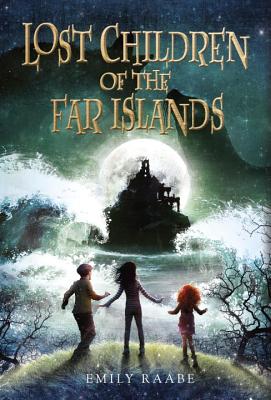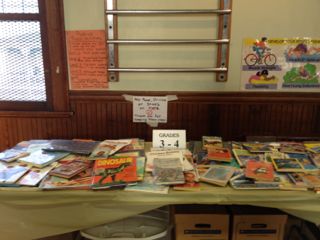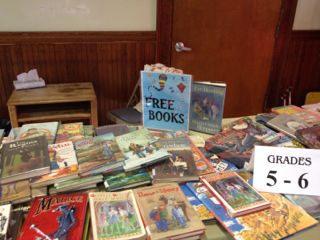Kids and books should always go together, but sometimes there are financial issues that prevent this. Last week I got to see a great program that worked to remedy this. Literacy Night at the Lothrop School strived to get every student a book.
 Last week, Emily Raabe, debut novelist of the recently published Lost Children of the Far Islands, and I traveled down to Pittsford, Vermont to the Lothrop School for their annual literacy night. Emily was our first-ever employee 17 years ago. It’s a real thrill to be able to sell her book! There is a lovely symmetry to that which delights me. Emily’s sister, Sara (also a former Flying Pig staffer), just happens to be the principal of the school. Their literacy night includes kids in jammies (see this post for how literacy night worked in Maine with Elizabeth Bluemle) and children having different classrooms to hear different stories, then coming back together as a group for an author reading.
Last week, Emily Raabe, debut novelist of the recently published Lost Children of the Far Islands, and I traveled down to Pittsford, Vermont to the Lothrop School for their annual literacy night. Emily was our first-ever employee 17 years ago. It’s a real thrill to be able to sell her book! There is a lovely symmetry to that which delights me. Emily’s sister, Sara (also a former Flying Pig staffer), just happens to be the principal of the school. Their literacy night includes kids in jammies (see this post for how literacy night worked in Maine with Elizabeth Bluemle) and children having different classrooms to hear different stories, then coming back together as a group for an author reading.

 Of course the kids were adorable, and yes, there was much discussion about books and stories. But what made this event stand out were the free books for the kids. I walked in the gym and there were four tables of books arranged by ages from first grade right through fifth. As kids streamed into the gym they circled the tables and eyed the books they knew they couldn’t touch until after the presentation. The kids at this school are among Vermont’s rural poor with almost half of them qualifying for free lunches. Pittsford is a town that reflects the changing face of Vermont with a mix of farming kids and kids whose families have been caught up in heroin and meth addictions.
Of course the kids were adorable, and yes, there was much discussion about books and stories. But what made this event stand out were the free books for the kids. I walked in the gym and there were four tables of books arranged by ages from first grade right through fifth. As kids streamed into the gym they circled the tables and eyed the books they knew they couldn’t touch until after the presentation. The kids at this school are among Vermont’s rural poor with almost half of them qualifying for free lunches. Pittsford is a town that reflects the changing face of Vermont with a mix of farming kids and kids whose families have been caught up in heroin and meth addictions.
This was Emily’s first event for her book and she did really well. The kids seemed to have a hard time settling down and were a little chatty throughout her reading. While they may have been talking, they were paying good attention and asked many questions about the book and being a writer. One child asked, after hearing how many drafts Emily wrote, “Why don’t you have gray hair?” Emily deftly handled this one. She was also extremely kind when kids misheard her asking if they knew what a selkie myth was and hands shot up and a boy said, “I know what a selfie is: it’s when you take your picture with a phone.”
Kids bought Emily’s book and while they were waiting to get them personalized, the book tables were opened. Sara explained, “We’re going for controlled chaos.” Children streamed to the appropriate tables and carefully choose one book each that had been scoped out before. Every student left with a book. And I was left with a very happy feeling to be part of such of a special evening.

Where did the school get the free books? And, how did they pay for them?
I’m curious too, where were the books from?
It’s hard to tell from the photo, but some of the books look a little worn. Perhaps the books were donated.
Our company, Brigantine Media, is involved in a program called MyBooks that gives free books to school children in Vermont. MyBooks funds the program through various foundations, grants, and donors, working with the nonprofit Northeast Kingdom Learning Services. We’ve had the pleasure of being part of an effort to give children in northern Vermont free books, and their delight in receiving new books is wonderful. As Josie describes, many of these kids are from homes where a new book is a luxury, so they are especially excited to take home these books and share them with their siblings and parents.
This reminds me of a Reading Is Fundamental (RIF) book distribution. Once upon a time RIF had significant Federal support which they used to leverage additional private funds to ensure that kids had books of their own choosing to keep. Combining free books with activities to motivate kids to read seems like an investment we should still be making.
I’m sorry. I totally forgot to mention that all of the books were donated from a myriad of sources. And some were in better shape than others. But all found good homes.